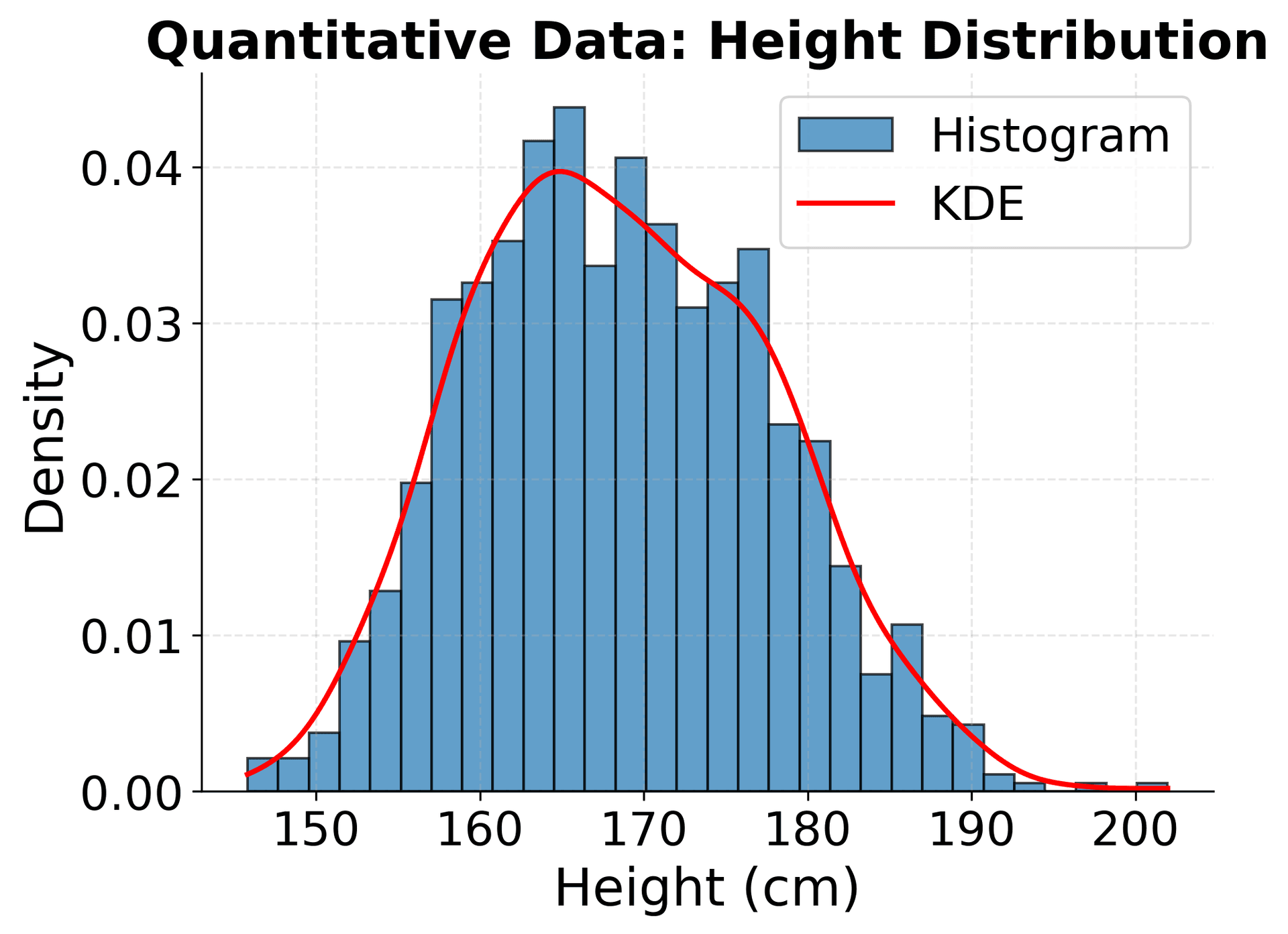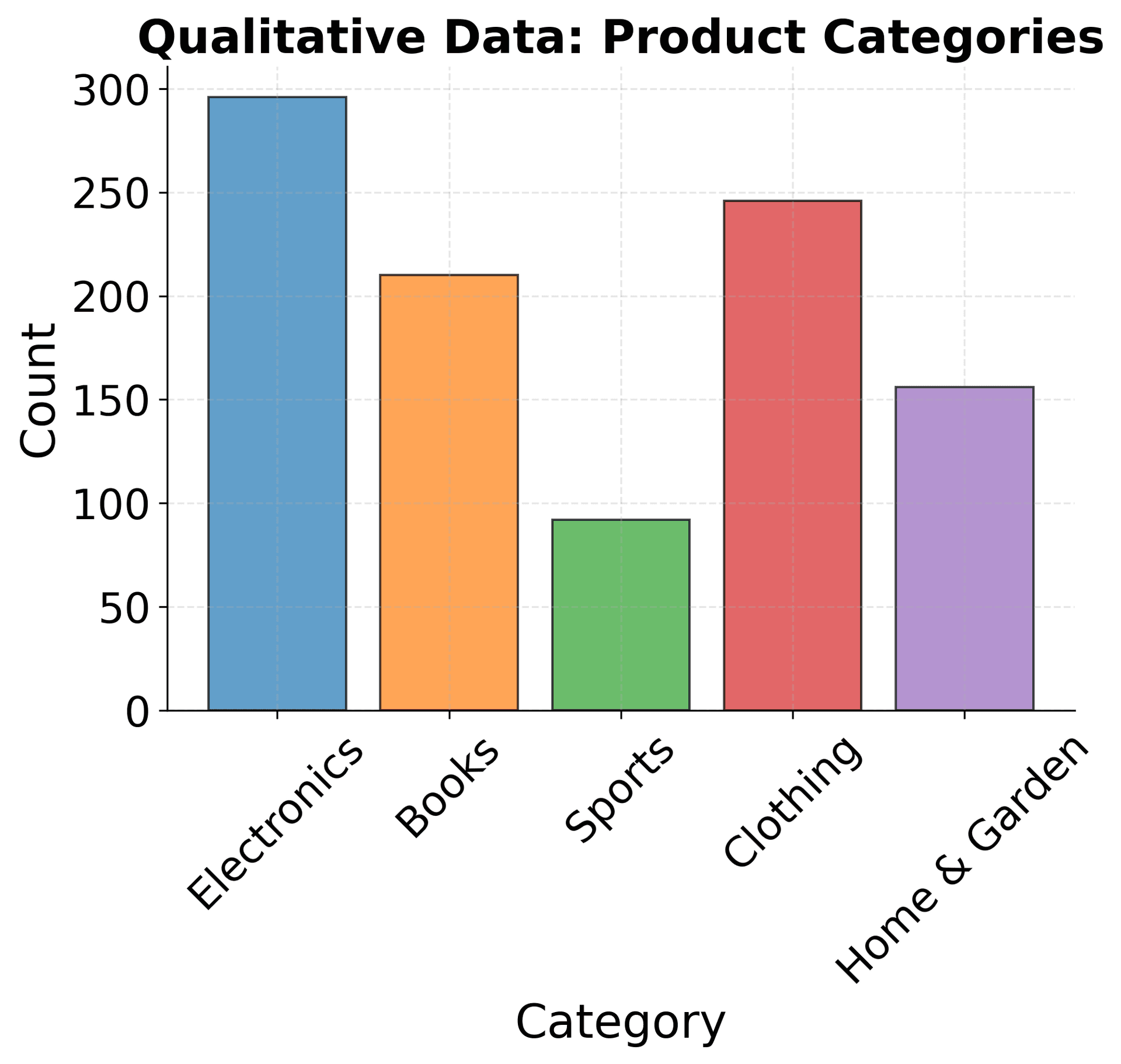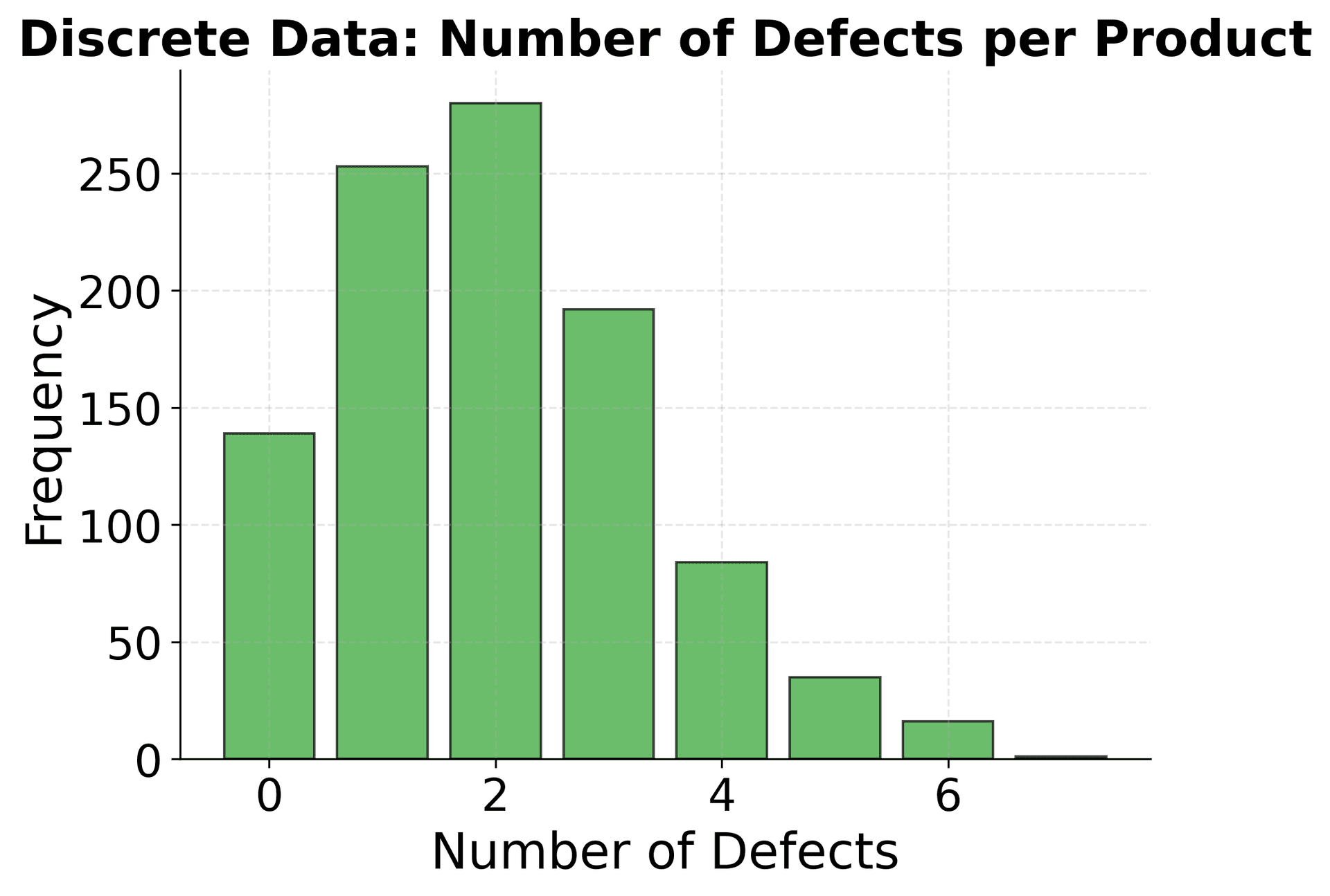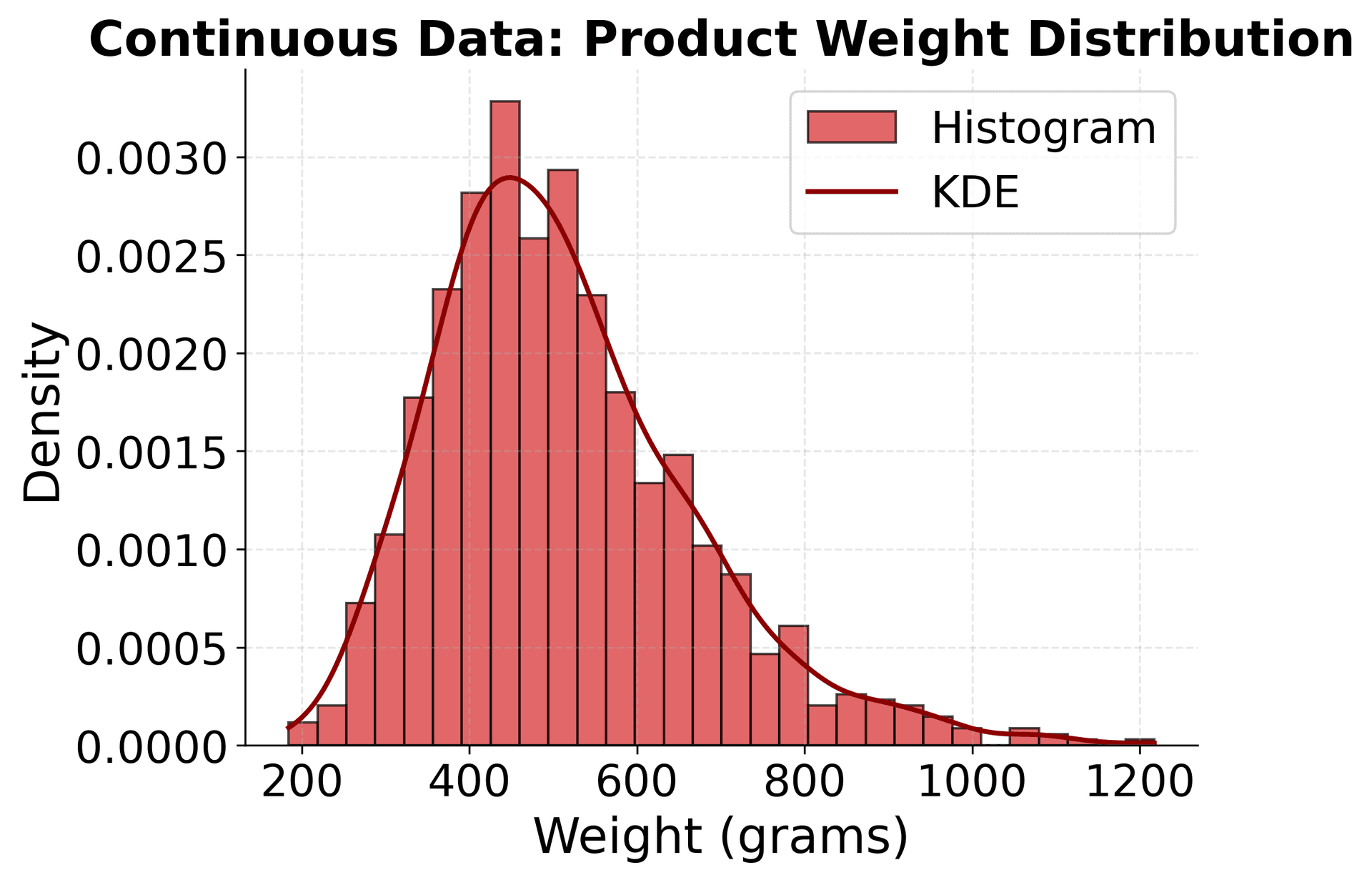Master data classification with this comprehensive guide covering quantitative vs. qualitative data, discrete vs. continuous data, and the data type hierarchy including nominal, ordinal, interval, and ratio scales. Learn how to choose appropriate analytical methods, avoid common pitfalls, and apply correct preprocessing techniques for data science and machine learning projects.

This article is part of the free-to-read Data Science Handbook
Choose your expertise level to adjust how many terms are explained. Beginners see more tooltips, experts see fewer to maintain reading flow. Hover over underlined terms for instant definitions.
Types of Data: Understanding Data Classification
Understanding different types of data is fundamental to data science and AI, as it determines which analytical methods, statistical tests, and machine learning algorithms are appropriate for your analysis. This chapter provides an overview of data classification systems and their practical implications.
Introduction
Data is the foundation of any data science project. The type of data you're working with directly influences your choice of statistical methods, visualization techniques, and machine learning algorithms. Proper data classification ensures that you apply appropriate analytical techniques and interpret results correctly.
In this chapter, we'll explore the primary classification systems used in data science: quantitative vs. qualitative data, and discrete vs. continuous data. Understanding these distinctions is crucial for selecting appropriate analytical methods and avoiding common pitfalls in data analysis.
Core Data Classification Systems
Quantitative vs. Qualitative Data
The most fundamental distinction in data science is between quantitative (numerical) and qualitative (categorical) data.
Quantitative Data
Quantitative data consists of numerical values that represent measurable quantities. These values can be subjected to mathematical operations and statistical analysis. When we think of quantitative data, we're dealing with numbers that represent actual measurements or counts. For instance, when we measure someone's height in centimeters, record their income in dollars, or count the number of defects in a product, we're working with quantitative data.
The key characteristic of quantitative data is that it consists of numerical values that can be measured and counted. This numerical nature allows us to perform mathematical operations like addition, subtraction, multiplication, and division. We can calculate meaningful statistics such as means, medians, and standard deviations. Common examples include height, weight, income, temperature, and age.
Example: Quantitative vs. Qualitative Data Visualization
This example demonstrates the visual differences between quantitative and qualitative data:

Quantitative data visualization showing numerical values (height in cm) with a histogram and kernel density estimation (KDE) overlay. The bimodal distribution reflects realistic human height patterns, with separate peaks for male and female populations. The continuous nature of quantitative data allows for statistical measures like mean, median, and standard deviation, enabling mathematical operations and statistical analysis.

Qualitative data visualization showing categorical values (product categories) with a bar chart. The discrete, non-numerical nature of qualitative data requires different analytical approaches, focusing on frequency counts and proportions rather than mathematical operations.
Qualitative Data
Qualitative data, on the other hand, consists of non-numerical values that represent categories, labels, or attributes. This type of data describes qualities or characteristics rather than quantities. When we categorize people by gender, classify products by brand, or group regions by location, we're working with qualitative data.
The defining characteristic of qualitative data is that it consists of non-numerical values that represent categories or groups. Unlike quantitative data, these values cannot be subjected to mathematical operations in a meaningful way. We cannot add "male" and "female" or multiply "red" by "blue." Instead, we work with frequencies, proportions, and patterns within these categories. Typical examples include gender, color, brand, region, and education level.
Discrete vs. Continuous Data
Within quantitative data, we can further distinguish between discrete and continuous data.
Discrete Data
Discrete data consists of countable values with distinct, separate values. Think of discrete data as data that comes in whole numbers or distinct categories that can be counted. When we count the number of students in a classroom, tally the defects in a manufacturing process, or count the cars in a parking lot, we're working with discrete data.
Mathematical Definition: A variable is discrete if it can only take on a finite or countably infinite set of values.
The fundamental characteristic of discrete data is that it consists of countable values that are distinct and separate. There are no intermediate values between data points—you cannot have 2.5 students or 3.7 defects. Each value represents a complete, countable unit. This makes discrete data particularly suitable for counting operations and frequency analysis. Common examples include the number of students, count of defects, and number of cars.
Example: Discrete vs. Continuous Data
This example illustrates the differences between discrete and continuous data:

Discrete data showing countable values (number of defects per product) with distinct, separate values. Each bar represents a specific count, and there are no intermediate values between data points, demonstrating the countable nature of discrete data.

Continuous data showing measurable values (product weight in grams) with a histogram and kernel density estimation (KDE) overlay. The right-skewed log-normal distribution reflects realistic weight patterns, where most products cluster around the mean with some heavier outliers. The data can take any value within a range, demonstrating the infinitely divisible nature of continuous data.
Continuous Data
Continuous data consists of values that can take on any value within a range. Unlike discrete data, continuous data can theoretically take on any value within a given interval, making it infinitely divisible. When we measure height, weight, temperature, or time, we're working with continuous data.
Mathematical Definition: A variable is continuous if it can take on any value within an interval where .
The key characteristic of continuous data is that it can take any value within a range and is infinitely divisible. Between any two continuous values, there are infinitely many other possible values. For example, between 170.0 cm and 170.1 cm in height, there are infinitely many possible measurements. This continuous nature makes it suitable for precise measurements and allows for sophisticated statistical analysis. Typical examples include height, weight, temperature, and time.
Data Type Hierarchy and Subcategories
Nominal vs. Ordinal Data
Within qualitative data, we can distinguish between nominal and ordinal data, each requiring different analytical approaches.
Nominal Data
Nominal data consists of categories without any inherent order or ranking. These categories are simply labels that help us classify observations into different groups. The order of these categories is arbitrary and has no mathematical meaning. For example, when we categorize people by gender (male, female, other), classify products by color (red, blue, green), or group companies by region (North, South, East, West), we're working with nominal data. These categories cannot be ranked or ordered in any meaningful way.
Ordinal Data
Ordinal data consists of categories that have an inherent order or ranking, but the intervals between categories may not be equal. While we can say that one category is "greater than" or "less than" another, we cannot assume that the difference between categories is uniform. For example, education levels (high school, bachelor's, master's, doctorate) have a clear order, but the difference between high school and bachelor's may not be the same as the difference between bachelor's and master's. Other examples include satisfaction ratings (poor, fair, good, excellent) and grade levels (A, B, C, D, F).
Interval vs. Ratio Data
Within quantitative data, we can distinguish between interval and ratio data based on the presence of a true zero point and the types of mathematical operations that are meaningful.
Interval Data
Interval data consists of numerical data with equal intervals between values, but no true zero point. This means that while we can perform addition and subtraction operations, multiplication and division are not meaningful. The zero point is arbitrary and doesn't represent the complete absence of the measured attribute. For example, temperature in Celsius has equal intervals (the difference between 20°C and 30°C is the same as between 30°C and 40°C), but 0°C doesn't represent the complete absence of temperature. Other examples include IQ scores and calendar years.
Ratio Data
Ratio data consists of numerical data with equal intervals and a true zero point that represents the complete absence of the measured attribute. This allows for all mathematical operations, including multiplication and division, which are meaningful and interpretable. For example, height has a true zero point (0 cm means no height), and we can say that someone who is 180 cm tall is twice as tall as someone who is 90 cm tall. Common examples include height, weight, income, and age.
Practical Applications
Understanding data types is crucial for selecting appropriate analytical methods and ensuring accurate interpretation of results. The choice of data type directly influences every aspect of the data science workflow.
Statistical Analysis
The type of data you're working with determines which statistical tests are appropriate. For quantitative data, we can use parametric tests such as t-tests, ANOVA, and correlation analysis, which assume specific distributional properties. These tests are powerful when their assumptions are met, allowing us to make inferences about population parameters. However, for qualitative data, we must rely on non-parametric tests like chi-square tests and Mann-Whitney U tests, which make fewer assumptions about the underlying distribution.
Machine Learning
Different data types require different machine learning approaches. Numerical data works well with algorithms like linear regression and neural networks, which can directly process continuous values. Categorical data, on the other hand, requires special handling through algorithms like decision trees and Naive Bayes, which can work with discrete categories. When dealing with mixed data types, we often need to use ensemble methods or apply sophisticated data preprocessing techniques to handle both numerical and categorical variables effectively.
Data Visualization
The choice of visualization technique depends heavily on the data type. Quantitative data lends itself to histograms, scatter plots, and box plots, which can reveal distributional properties and relationships between variables. Qualitative data is best visualized through bar charts, pie charts, and mosaic plots, which emphasize frequency counts and proportions. Time series data requires specialized visualizations like line plots and seasonal decomposition plots to reveal temporal patterns.
Data Preprocessing
Data preprocessing strategies must be tailored to the specific data type. For numerical data, we typically focus on scaling, normalization, and outlier detection to ensure that variables are on comparable scales and that extreme values don't unduly influence our models. Categorical data requires encoding techniques such as dummy variables, frequency encoding, or target encoding to convert categories into numerical representations that machine learning algorithms can process.
Common Pitfalls and Considerations
Data Type Misclassification
One of the most common mistakes in data analysis is misclassifying data types, particularly treating ordinal data as nominal. When we have ordinal data like education levels or satisfaction ratings, we must use statistical tests that respect the inherent ordering. Using tests designed for nominal data would lose valuable information about the relationships between categories. The solution is to carefully examine your data and use appropriate statistical tests that match the data's inherent properties.
Measurement Scale Assumptions
Another frequent error is assuming that interval data has ratio properties. For example, treating temperature in Celsius as if it has a meaningful zero point can lead to incorrect conclusions. While we can say that 30°C is warmer than 20°C, we cannot say that 30°C is "twice as hot" as 15°C. The solution is to verify the measurement scale before analysis and choose statistical methods that are appropriate for the scale of measurement.
Mixed Data Types
When working with datasets that contain both numerical and categorical variables, it's easy to ignore the differences between data types and apply uniform preprocessing. This can lead to suboptimal results and misinterpretation of findings. The solution is to apply appropriate preprocessing techniques for each data type, ensuring that numerical variables are scaled appropriately while categorical variables are encoded correctly.
Over-discretization
Sometimes analysts convert continuous data to discrete categories unnecessarily, losing valuable information in the process. For example, converting age into broad categories like "young," "middle-aged," and "old" when the original continuous age data would provide more precise insights. The solution is to preserve the original data granularity whenever possible and only discretize when it serves a specific analytical purpose.
Summary
Understanding data types is fundamental to data science and AI. The primary classification between quantitative and qualitative data determines the analytical methods you can apply, while the distinction between discrete and continuous data affects your choice of statistical tests and machine learning algorithms.
The key takeaway is that quantitative data enables mathematical operations and statistical analysis, while qualitative data requires categorical analysis and frequency-based methods. Within quantitative data, discrete data consists of countable, distinct values, whereas continuous data can take any value within a range. Proper data classification ensures appropriate analytical techniques and accurate interpretation of results.
Always verify your data types before analysis and choose methods that are appropriate for your data's characteristics. This foundation will guide your entire data science workflow, from data collection to model interpretation. By understanding these fundamental distinctions, you'll be better equipped to select the right tools and techniques for your specific data and analytical goals.
Quiz
Ready to test your understanding of data types? Challenge yourself with this quiz to see how well you've grasped the concepts of quantitative vs. qualitative data, discrete vs. continuous data, and the various data classification systems. Good luck!
Reference

About the author: Michael Brenndoerfer
All opinions expressed here are my own and do not reflect the views of my employer.
Michael currently works as an Associate Director of Data Science at EQT Partners in Singapore, where he drives AI and data initiatives across private capital investments.
With over a decade of experience spanning private equity, management consulting, and software engineering, he specializes in building and scaling analytics capabilities from the ground up. He has published research in leading AI conferences and holds expertise in machine learning, natural language processing, and value creation through data.
Related Content

NHITS: Neural Hierarchical Interpolation for Time Series Forecasting with Multi-Scale Decomposition & Implementation
Master NHITS (Neural Hierarchical Interpolation for Time Series), a deep learning architecture for multi-scale time series forecasting. Learn hierarchical decomposition, neural interpolation, and how to implement NHITS for complex temporal patterns in retail, energy, and financial data.

N-BEATS: Neural Basis Expansion Analysis for Time Series Forecasting
Complete guide to N-BEATS, an interpretable deep learning architecture for time series forecasting. Learn how N-BEATS decomposes time series into trend and seasonal components, understand the mathematical foundation, and implement it in PyTorch.

HDBSCAN Clustering: Complete Guide to Hierarchical Density-Based Clustering with Automatic Cluster Selection
Complete guide to HDBSCAN clustering algorithm covering density-based clustering, automatic cluster selection, noise detection, and handling variable density clusters. Learn how to implement HDBSCAN for real-world clustering problems.
Stay updated
Get notified when I publish new articles on data and AI, private equity, technology, and more.

